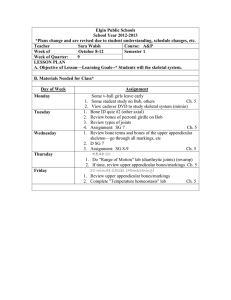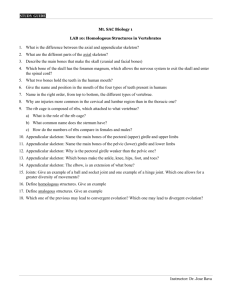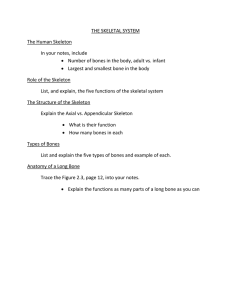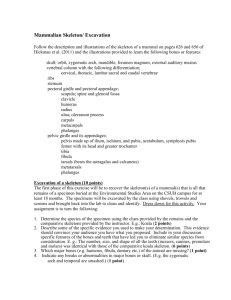008_NA_Appendicular_MLP_ENG
advertisement
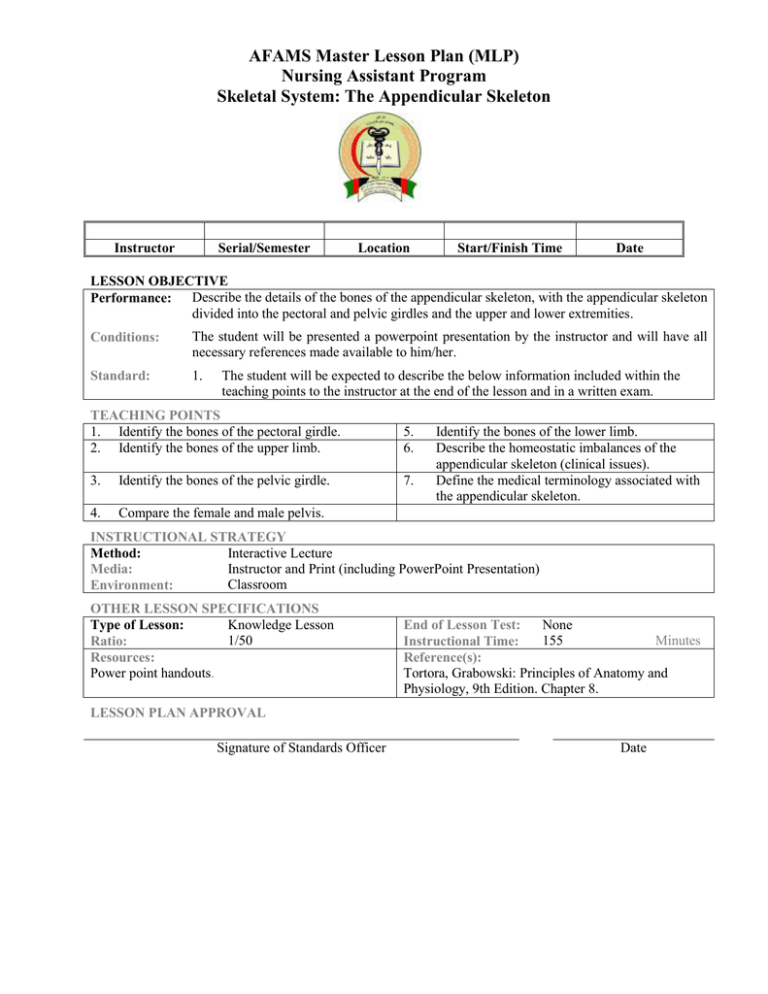
AFAMS Master Lesson Plan (MLP) Nursing Assistant Program Skeletal System: The Appendicular Skeleton Instructor Serial/Semester Location Start/Finish Time Date LESSON OBJECTIVE Performance: Describe the details of the bones of the appendicular skeleton, with the appendicular skeleton divided into the pectoral and pelvic girdles and the upper and lower extremities. Conditions: The student will be presented a powerpoint presentation by the instructor and will have all necessary references made available to him/her. Standard: 1. The student will be expected to describe the below information included within the teaching points to the instructor at the end of the lesson and in a written exam. TEACHING POINTS 1. Identify the bones of the pectoral girdle. 2. Identify the bones of the upper limb. 5. 6. 3. Identify the bones of the pelvic girdle. 7. 4. Compare the female and male pelvis. Identify the bones of the lower limb. Describe the homeostatic imbalances of the appendicular skeleton (clinical issues). Define the medical terminology associated with the appendicular skeleton. INSTRUCTIONAL STRATEGY Interactive Lecture Method: Instructor and Print (including PowerPoint Presentation) Media: Classroom Environment: OTHER LESSON SPECIFICATIONS Knowledge Lesson Type of Lesson: 1/50 Ratio: Resources: Power point handouts. None End of Lesson Test: 155 Minutes Instructional Time: Reference(s): Tortora, Grabowski: Principles of Anatomy and Physiology, 9th Edition. Chapter 8. LESSON PLAN APPROVAL Signature of Standards Officer Date AFAMS Master Lesson Plan (MLP) Nursing Assistant Program Skeletal System: The Appendicular Skeleton INTRODUCTION Allocated Time: Review: 5 Minutes You have had previous lectures on anatomy and physiology during the Combat medic course, this lecture will built upon what you have already learned. Objective: This chapter introduces the details of the bones of the appendicular skeleton, with the appendicular skeleton divided into the pectoral and pelvic girdles and the upper and lower extremities. Bone markings, functions, and articulations with adjacent bones are covered. Clinical applications that are covered include fractured clavicle, knock-knee and bowleg, patellofemoral stress syndrome, and flatfoot, clawfoot, and clubfoot. Hip fracture is discussed in the disorders section. Importance: Nursing Assistants work in different health care setting so it is important to gain an understainding of this subject as it will apply to clinical setting. Fit: This is the eighth chapter on anatomy and physiology. Approach: You will be presented the subject in a lecture format and will be tested using a written exam at a later date. Control Statement: If you have any questions during the lesson please feel free to ask. BODY 1. Teaching Point: Identify the bones of the pectoral girdle. Minutes Allocated Time: We will now go over the bones of the pectoral girdle. Introduction: Learner Participation: Knowledge Lesson Please follow along with your handouts and take notes. Skill Lesson Powerpoint presentation with associated handouts. Learning Support: 1. Identify the bones that make up the appendicular skeleton. 2. Identify the bones of the pectoral girdle and the only point of attachment of the girdle to the axial skeleton. Clavicle 3. Identify the clavicle, its markings, functions, and the bones with which it articulates. 4. Discuss the problems associated with a fractured clavicle. Scapula 5. Identify the scapula, its markings, functions, and the bones with which it articulates. 1 AFAMS Master Lesson Plan (MLP) Nursing Assistant Program Skeletal System: The Appendicular Skeleton Knowledge Lesson: Skill Lesson: Check on Learning In a knowledge lesson, pose questions to the class. In a skill lesson, provide practice and watch students perform a skill. 2. Teaching Point: Identify the bones of the upper limb. Minutes Allocated Time: We will now go over the bones of the upper limb. Introduction: Learner Participation: Knowledge Lesson Please follow along with your handouts and take notes. Skill Lesson Powerpoint presentation with associated handouts. Learning Support: 6. Identify the upper extremity, its component bones, and their number. Humerus 7. Identify the humerus, its major markings, functions, and peculiar contours that allow it to articulate with the scalpular glenoid fossae and the ulnar trochlear notch. Ulna and Radius 8. Identify the ulna, its major markings, functions, and peculiar contours that allow it to have a major articulation with the humeral trochlea and minor interaction with the carpals. 9. Identify the radius, its major markings, functions, and contours that allow it to have a major articulation with the carpals and minor interaction with the humeral trochlea. Carpals, Metacarpals, and Phalanges 10. Identify the names and positions of the carpals. 11. Identify the names and positions of the metacarpals. 12. Identify the names and positions of the phalanges. Knowledge Lesson: Skill Lesson: Check on Learning In a knowledge lesson, pose questions to the class. In a skill lesson, provide practice and watch students perform a skill. 3. Teaching Point: Identify the bones of the pelvic girdle. Minutes Allocated Time: We will now go over the bones of the pelvic girdle. Introduction: Learner Participation: Knowledge Lesson Please follow along with your handouts and take notes. Skill Lesson Powerpoint presentation with associated handouts. Learning Support: 13. Identify the bones and function of the pelvic girdle. Ilium 2 AFAMS Master Lesson Plan (MLP) Nursing Assistant Program Skeletal System: The Appendicular Skeleton 14. Identify the ilium, its major markings, functions, and the bones with which it articulates. Ischium 15. Identify the ischium, its major markings, functions, and the bones with which it articulates. Pubis 16. Identify the pubis, its major markings, functions, and the bones with which it articulates. True and False Pelves 17. Distinguish between the true and false pelves and give the function of the bony pelvis. Knowledge Lesson: Skill Lesson: Check on Learning In a knowledge lesson, pose questions to the class. In a skill lesson, provide practice and watch students perform a skill. 4. Teaching Point: Compare the female and male pelvis. 5 Minutes Allocated Time: We will now go over the female and male pelvises. Introduction: Learner Participation: Knowledge Lesson Please follow along with your handouts and take notes. Skill Lesson Powerpoint presentation with associated handouts. Learning Support: 18. Compare and contrast the principal structural differences between female and male pelvises. Knowledge Lesson: Skill Lesson: Check on Learning In a knowledge lesson, pose questions to the class. In a skill lesson, provide practice and watch students perform a skill. 5. Teaching Point: Identify the bones of the lower limb. Minutes Allocated Time: Introduction: We will now go over the bones of the lower limb. Learner Participation: Knowledge Lesson Please follow along with your handouts and take notes. Skill Lesson Powerpoint presentation with associated handouts. Learning Support: 20. Identify the lower extremity and its component bones. Femur 3 AFAMS Master Lesson Plan (MLP) Nursing Assistant Program Skeletal System: The Appendicular Skeleton 21. Identify the femur, its major markings, functions, and surface shapes that allow allow it to articulate with the coxal acetabulum and pedal talus. 22. Discuss the pathological changes that result in knock-knee and bowleg. Patella 23. Discuss the patella in terms of its bone type, its location, and its function. 24. Discuss the cause and effect of patellofemoral stress syndrome. Tibia and Fibula 25. Distinguish between the tibia and fibula in terms of their size, features, location, purpose, and articular surfaces. Tarsals, Metatarsals, and Phalanges 26. Compare the number, size, and function of the tarsal, metatarsal, and phalangeal bones of the foot with the corresponding bones of the hand. Arches of the Foot 27. Define the structural features and importance of the arches of the foot. 28. Discuss the possible causes of flatfoot, clawfoot, and clubfoot. 6. Teaching Point: Describe the homeostatic imbalances of the appendicular skeleton. Minutes Allocated Time: We will now go over the homeostatic imbalances of the appendicular skeleton. Introduction: Learner Participation: Knowledge Lesson Please follow along with your handouts and take notes. Skill Lesson PowerPoint presentation with associated handouts. Learning Support: 29. Explain that the term hip fracture applies to a break in any bone associated with the hip joint. 30. Discuss the clinical conditions of flatfoot and clawfoot. 7. Teaching Point: Define the medical terminology associated with the appendicular skeleton. Minutes Allocated Time: We will now go over the medical terminology associated with the appendicular Introduction: skeleton. Learner Participation: Knowledge Lesson Please follow along with your handouts and take notes. Skill Lesson Powerpoint presentation with associated handouts. Learning Support: 31. Define the medical terminology associated with the appendicular skeleton. 4 AFAMS Master Lesson Plan (MLP) Nursing Assistant Program Skeletal System: The Appendicular Skeleton Knowledge Lesson: Skill Lesson: Check on Learning In a knowledge lesson, pose questions to the class. In a skill lesson, provide practice and watch students perform a skill. END OF LESSON TEST Allocated Time: Instructions: Test Questions or Performance Expected: Test Key: 0 Minutes You will tested on this subject at a later date. You will be expected to review and study the material taught in this section in order to pass the associated written test. If you have difficulty with the material please see me so we can review together. CONCLUSION Allocated Time: Summary: 5 Minutes Review and re-emphasize the difficult Teaching Points below. 1. 2. 3. 4. 5. 6. 7. 8. 9. Identify the bones of the pectoral girdle. Identify the bones of the upper limb. Identify the bones of the pelvic girdle. Compare the female and male pelvic. Compare the pectoral and pelvic girdles. Identify the bones of the lower limb. Identify the skeletal system’s contribution to homeostasis. Describe the homeostatic imbalances of the appendicular skeleton. Define the medical terminology associated with the appendicular skeleton. Closing Statement: Nursing Assistants work in different health care setting so it is important to gain an understainding of this subject as it will apply to clinical setting. Re-motivating Statement: You will be able to utilize this information taught today in all clinical settings. 5
